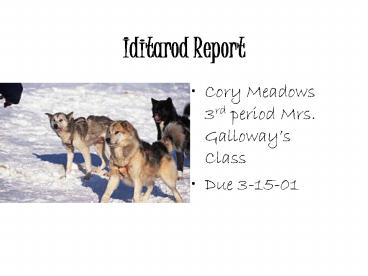Iditarod Report - PowerPoint PPT Presentation
1 / 12
Title:
Iditarod Report
Description:
... the disease diphtheria loomed over the small town of Nome, Alaska in 1925. ... racing career including the Alaska Airlines Leonhard Seppala Humanitarian Award. ... – PowerPoint PPT presentation
Number of Views:144
Avg rating:3.0/5.0
Title: Iditarod Report
1
Iditarod Report
- Cory Meadows 3rd period Mrs. Galloways Class
- Due 3-15-01
2
The Iditarod
- An outbreak of the disease diphtheria loomed over
the small town of Nome, Alaska in 1925. A
medicine was needed to immunize the townspeople
but it was in short supply. Bad weather in the
area kept airplanes from Fairbanks on the ground.
The medicine was instead rushed from Nenana to
Nome, about 675 miles, by dog teams. The medicine
was relayed the distance in just 127.5 hours.
3
The Iditarod continued
- The Iditarod Sled Dog Race is run to honor the
historic medicine run. The race begins in
Anchorage during the first weekend in March. From
the first 20-day run in 1973, the times have
fallen to under 10 days. After the first musher
reaches the burl arch in Nome, mushers continue
to flow in both day and night for a week and a
half.
4
The After Race Celebration
- At the end of the race, Nome becomes quite a
center of activity. Scheduled activities include
a potluck dinner, several crafts shows, the race
awards ceremonies including an opportunity to
meet the mushers, and an Alaskan sized basketball
tournament (over 50 teams attend the
competition). There is also the Ice Golf Classic
and a darts tournament.
5
My Mushers
- Dee Dee Jonrowe Willow, Alaska
- Dee Dee Jonrowe was born in Germany in 1953 while
her dad was in the service. She went to school in
Virginia and in 1971 the military brought their
family to Alaska.
6
Mushers continued
- She began mushing in 1979 and became interested
in the Iditarod after her mother shared her
interest in the race while Dee Dee lived in
Bethel. Dee Dee has won many awards during her
racing career including the Alaska Airlines
Leonhard Seppala Humanitarian Award. She is a
member of Big Lake Baptist Church, Valley Women's
Running Club and P.R.I.D.E.
7
Mushers continued
- Juan Alcina
- Willow, Alaska
- Juan Alcina was born in Malaga, Spain, in 1964.
He was an aircraft mechanic for 10 years in the
Spanish Air Force. Juan began mushing in 1990 in
the Pyrenees and moved to Alaska in 1991 with
plans to eventually run "The Last Great Race."
8
Mushers continued
- Juan's been an aircraft mechanic at the Anchorage
International Airport for the last four years. He
is a member of Club Slid and says he enjoys
spending time with his family and the dogs.
Maureen and Juan have a son, Javier, age 5, and
the newest member of their family, Neal, 1.
9
Mushers continued
- Ron Koczaja Kwethluk, AK
- Born and raised in Buffalo, New York, Ron
Koczaja, 29, attended college at the State
University of New York at Buffalo and graduated
with a degree in biology with a minor in
education.
10
Mushers continued
- Ron spent summers in Jackson Hole, Wyoming, where
he got into climbing and mountaineering. After
college, he decided to come to Alaska because of
all the huge mountains.
11
Mushers continued
Ironically, he ended up with a job in Kasigluk, a
village located in the middle of the huge flat
Kuskokwim delta no mountains or hills in sight.
He began running in 1995 with dogs that belonged
to Cauline Ferguson and got hooked. After a
year, he got his own dogs and began running with
Yukon Quest musher, Andrew Lesh. After three
years of mushing in the howling wind and on glare
ice and barren tundra, he moved to Kwethluk for
the trees, mountains and all around better trail
conditions. He said he decided to run the
Iditarod after he entered the Kuskokwim 300 with
the goal of just finishing and ended up
placing fairly respectably and ahead of some
Iditarod mushers. Ron is single. He says his
hobbies are camping and traveling.
12
Ending
- At the beginning the route was used for getting
medicine to a town and as a mail route.Now it
just run for fun. No matter how the course has
changed over the years its still beautiful, and
is still the last great race on earth.































